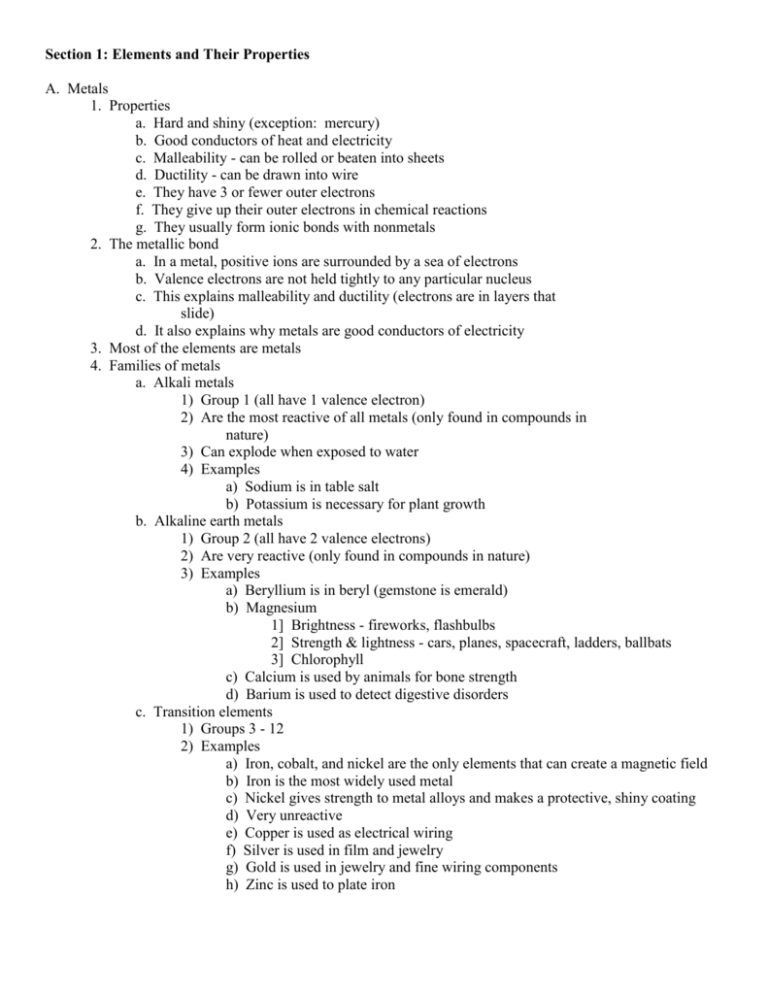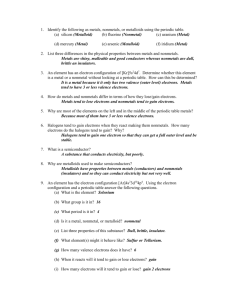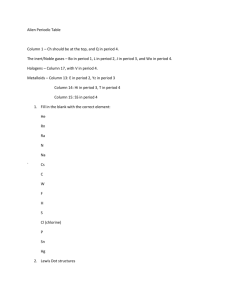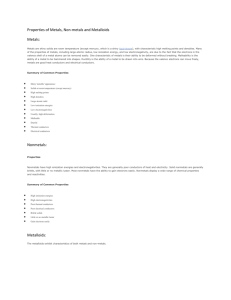MS Word document, click here
advertisement

Section 1: Elements and Their Properties A. Metals 1. Properties a. Hard and shiny (exception: mercury) b. Good conductors of heat and electricity c. Malleability - can be rolled or beaten into sheets d. Ductility - can be drawn into wire e. They have 3 or fewer outer electrons f. They give up their outer electrons in chemical reactions g. They usually form ionic bonds with nonmetals 2. The metallic bond a. In a metal, positive ions are surrounded by a sea of electrons b. Valence electrons are not held tightly to any particular nucleus c. This explains malleability and ductility (electrons are in layers that slide) d. It also explains why metals are good conductors of electricity 3. Most of the elements are metals 4. Families of metals a. Alkali metals 1) Group 1 (all have 1 valence electron) 2) Are the most reactive of all metals (only found in compounds in nature) 3) Can explode when exposed to water 4) Examples a) Sodium is in table salt b) Potassium is necessary for plant growth b. Alkaline earth metals 1) Group 2 (all have 2 valence electrons) 2) Are very reactive (only found in compounds in nature) 3) Examples a) Beryllium is in beryl (gemstone is emerald) b) Magnesium 1] Brightness - fireworks, flashbulbs 2] Strength & lightness - cars, planes, spacecraft, ladders, ballbats 3] Chlorophyll c) Calcium is used by animals for bone strength d) Barium is used to detect digestive disorders c. Transition elements 1) Groups 3 - 12 2) Examples a) Iron, cobalt, and nickel are the only elements that can create a magnetic field b) Iron is the most widely used metal c) Nickel gives strength to metal alloys and makes a protective, shiny coating d) Very unreactive e) Copper is used as electrical wiring f) Silver is used in film and jewelry g) Gold is used in jewelry and fine wiring components h) Zinc is used to plate iron i) Mercury 1] Liquid metal 2] Used in thermometers, thermostats, switches, batteries 3] Very poisonous B. Nonmetals 1. Properties a. Most are gases, some solids, one a liquid b. Dull, brittle, powdery c. Poor conductors of heat and electricity d. Can form either ionic or covalent bonds 2. Groups of nonmetals a. Hydrogen 1) 90% of all atoms in the universe are hydrogen 2) Diatomic 3) Very reactive a) May share its electron (as in water or HCl) b) May gain an electron in hydride bonds with alkali metals or alkaline earth metals b. Halogens 1) Group 17 2) Means "salt former" (when it reacts with a metal it forms a salt) 3) All are diatomic 4) Examples a) Fluorine 1] Used in hydrofluoric acid to etch glass and frost light bulbs 2] Added to water and toothpaste to prevent tooth decay b) Chlorine is used in cleaning products (bleach) c) Bromine (liquid) is used as dyes in cosmetics d) Iodine is added to salt to prevent goiters c. Noble gases 1) Group 18 2) Do not naturally react with any elements 3) Examples a) Helium is used in dirigibles b) Neon, argon, and krypton are used in lights and signs C. Mixed Groups 1. These groups may contain metals, metalloids, and nonmetals 2. Metalloids have properties of both metals and nonmetals 3. Groups 13 - 16 4. Examples a. Boron is used in borax (antiseptic) and water softener b. Aluminum 1) Most abundant metal in Earth's crust 2) Strength and lightness makes it good for airplanes c. Carbon 1) 4 valence electrons 2) Has allotropes of diamond, graphite, and buckminsterfullerene 3) Used in food and fuel d. Silicon 1) Most is found in sand (silicon dioxide) 2) Crystal structure similar to diamond 3) Used to make semiconductors for computer chips e. Germanium is used to make semiconductors f. Tin is used to coat other metals and to make bronze and pewter g. Lead is a soft metal that is poisonous h. Nitrogen 1) Diatomic 2) Makes up 78% of our air and is used in fertilizers and explosives i. Phosphorus is used in explosives, fertilizers, matches, and water softeners j. Bismuth is used to turn on automatic fire sprinkler heads k. Oxygen 1) Diatomic 2) Has allotropes of normal oxygen and ozone molecules 3) Combines with almost every other element to form oxides l. Sulfur is used in paint pigments









